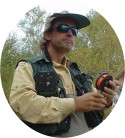I have always liked this story. Probably because it places the fish in the center of the circle and, extolling the creature, changes it into judge and lord. From our position around it, we dare to be something more than mere observers. We try to read and understand its messages although we know that we will never achieve complete understanding. This humble, respectful role is the most difficult to accept, probably the only one that we should often assume in this delicate ebb and flow of the waters and of life.
|
 History holds a North American angler, Vincent Marinaro, to be one of the great fly fishing innovators. Author of, according to many, the greatest fishing book of his century, In the Ring of the Rise, Marinaro left us, among many other things, a
History holds a North American angler, Vincent Marinaro, to be one of the great fly fishing innovators. Author of, according to many, the greatest fishing book of his century, In the Ring of the Rise, Marinaro left us, among many other things, a  profound study of the behavior of trout and how they react to a fly.
profound study of the behavior of trout and how they react to a fly.
In his Nods, Marinaro uses a process of trial and error to understand and cope with those super-selective trout that often stymie us.
The game starts by tying an imitation of the insect that the trout is eating plus quite a few variations of that basic model with very slight differences in the pattern. These are offered to a rising trout and its reaction is carefully noted.
A trout has different ways of showing interest in a fly.

As a fly caster, I keep thinking of the accuracy and smoothness with which Marinaro must have presented each of the flies so that no casting error could influence the outcome of the experiment.
|
 Each fly presented receives some type of nod reaction, which is carefully noted. When an imitation gets no nod, it's discarded and replaced by a new variation, and they're all classified according to the number and type of nods they receive. At the end of the game, the imitations that merited the greatest number of specific nods are analyzed to identify the characteristics common to all the patterns in order to design the desired and perhaps successful ultimate imitation. Slow, but you can't get any more scientific..
Each fly presented receives some type of nod reaction, which is carefully noted. When an imitation gets no nod, it's discarded and replaced by a new variation, and they're all classified according to the number and type of nods they receive. At the end of the game, the imitations that merited the greatest number of specific nods are analyzed to identify the characteristics common to all the patterns in order to design the desired and perhaps successful ultimate imitation. Slow, but you can't get any more scientific..

